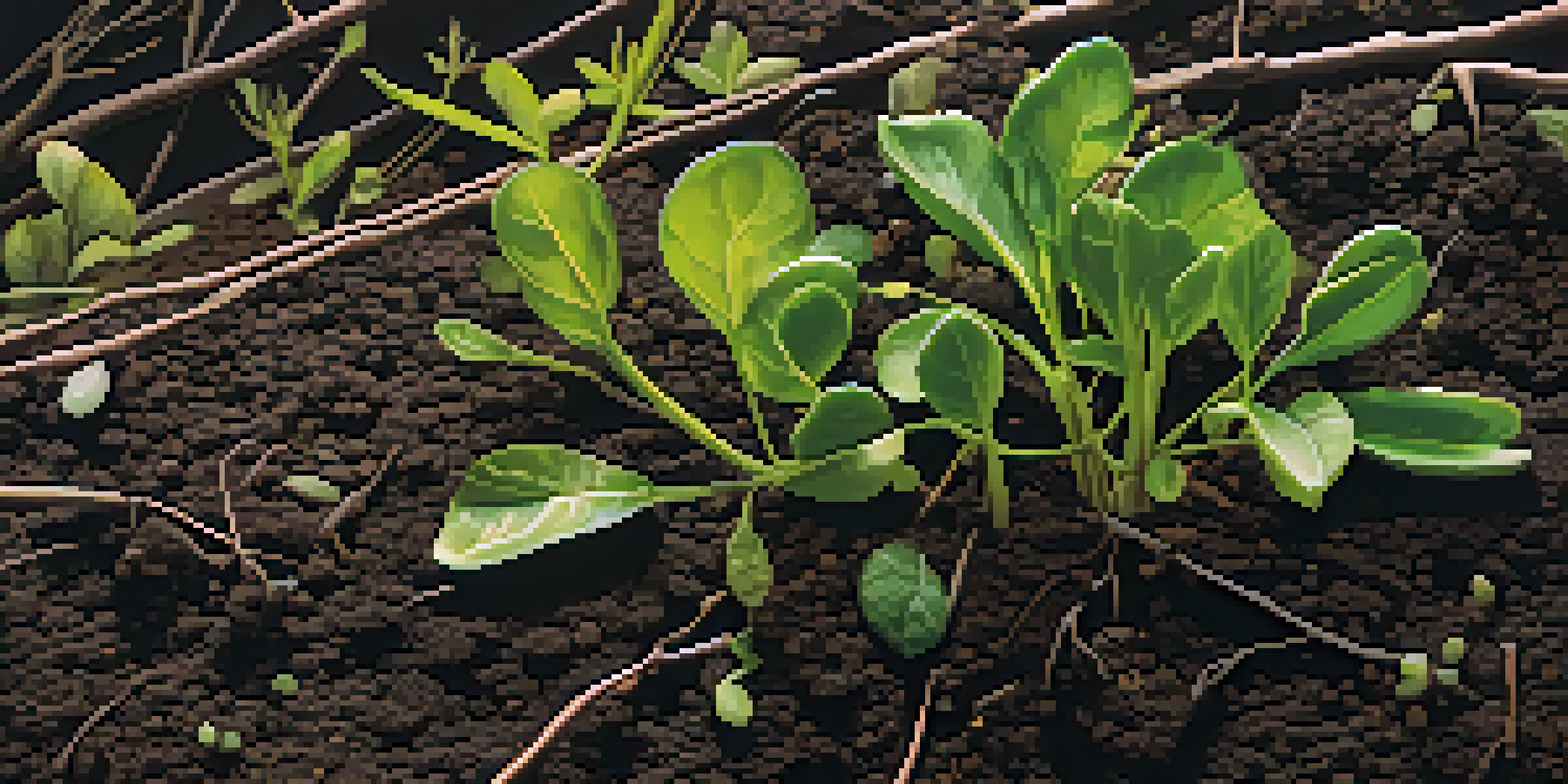The Impact of Soil Composition on Plant Behavioral Adaptations

Understanding Soil Composition and Its Components
Soil composition refers to the various elements and nutrients that make up soil, including minerals, organic matter, air, and water. Each of these components plays a vital role in the overall health of the soil and, consequently, the plants that grow in it. For instance, sandy soils drain quickly and often lack nutrients, while clay soils retain moisture but can become compacted. This diverse range of soil types influences how plants adapt their behavior to thrive.
The soil is the great connector of our lives, the source and destination of all. Food, fiber, shelter, medicine - they all come from the soil. If we take care of it, it will take care of us.
The mineral content in soil, such as nitrogen, phosphorus, and potassium, is crucial for plant growth. These nutrients encourage processes like photosynthesis and root development. A plant growing in nutrient-rich soil might develop deeper roots to access these nutrients, whereas a plant in nutrient-poor soil may adapt by having a more extensive root system to search for resources. This fascinating interplay showcases nature's ability to adapt.
In addition to the mineral content, organic matter in the soil, like decomposed leaves and organisms, enhances soil fertility and structure. This organic layer provides essential nutrients and improves moisture retention. Plants that thrive in rich organic soils often exhibit rapid growth and vibrant foliage, illustrating how the right soil composition can foster healthy plant behavior.
The Role of Soil pH in Plant Adaptations
Soil pH is another important factor that affects plant behavior. It measures the acidity or alkalinity of the soil, which can significantly influence nutrient availability. For example, many plants prefer slightly acidic soils, around a pH of 6 to 7, as this range often maximizes nutrient absorption. When the pH strays too far from this range, plants may struggle to obtain essential nutrients, forcing them to adapt their growth strategies.

Plants in highly acidic soils might develop deeper root systems to access nutrients that are more soluble in such conditions. Conversely, in alkaline soils, plants may display adaptations like thicker leaves or protective coatings to minimize nutrient loss. These adaptations demonstrate the resilience of plants and their ability to survive in less-than-ideal conditions.
Soil Composition Influences Growth
The varied components of soil, such as minerals and organic matter, play a crucial role in plant health and adaptation.
Moreover, soil pH can influence microbial activity in the soil, which in turn affects plant health. Beneficial microbes thrive in optimal pH ranges, helping to break down organic matter and release nutrients. When plants are in soils with favorable pH levels, they can experience enhanced growth and vitality, showcasing the intricate relationship between soil composition and plant behavior.
Nutrient Availability and Plant Growth Strategies
Nutrient availability in soil is a key driver of plant behavior. Different plants require different nutrients in varying amounts. For example, legumes are known for their ability to fix nitrogen in the soil, enriching it for other plants. This symbiotic relationship between plants showcases how species adapt their growth strategies based on available nutrients, benefiting the ecosystem as a whole.
Healthy soil is the foundation of healthy plants, healthy animals, and healthy people.
When nutrients are abundant, plants tend to invest in growth, producing larger leaves and more flowers to attract pollinators. In contrast, when nutrients are scarce, plants might reduce leaf size and prioritize root growth in search of additional resources. This strategic shift can be likened to a business adapting its resources based on market conditions, showcasing the innovative nature of plants.
Additionally, some plants have developed unique adaptations to cope with nutrient-poor soils. For instance, certain carnivorous plants, like the Venus flytrap, have evolved to derive nutrients from insects. This remarkable adaptation demonstrates the lengths to which plants will go to survive when faced with challenging soil conditions, highlighting the dynamic relationship between soil composition and plant strategies.
The Impact of Soil Texture on Root Development
Soil texture, which refers to the size of soil particles, plays a significant role in root development. Sandy soils, composed of larger particles, allow for quick drainage but may not provide adequate anchorage for plants. On the other hand, clay soils are dense and can hold water but may restrict root growth due to compaction. This variance in texture directly influences how plants adapt their root systems to optimize their growth conditions.
For instance, plants in sandy soils often develop deeper and more extensive roots to search for water and nutrients. In contrast, plants in clay soils may develop shorter, thicker roots that can push through the dense material. This adaptive behavior showcases how plants are equipped to respond to their immediate environment, ensuring their survival and growth.
Soil pH Affects Nutrient Absorption
Soil pH significantly impacts nutrient availability, influencing how plants adapt their growth strategies.
Furthermore, the texture of the soil can impact the aeration and drainage, which are critical for root health. Plants that thrive in well-aerated soils tend to have more vigorous growth, while those in poorly drained soils may struggle. Understanding these adaptations can help gardeners and farmers create optimal growing conditions for their plants, fostering a healthy ecosystem.
The Influence of Soil Moisture on Plant Behavior
Soil moisture plays a crucial role in plant survival and growth. The amount of water available in the soil influences various physiological processes, including nutrient uptake and photosynthesis. Plants in well-drained soils often have access to moisture, leading to robust growth, while those in overly saturated soils may experience root rot and stunted growth. This relationship emphasizes the importance of moisture levels in determining plant behavior.
In response to varying soil moisture levels, plants exhibit a range of adaptations. Drought-tolerant plants may develop deep tap roots that reach underground water sources, while others may have waxy leaf coatings to minimize water loss. These adaptations allow plants to thrive in environments with limited moisture, showcasing their resilience and ingenuity.
Moreover, during periods of excessive rainfall, some plants may develop adaptations to cope with waterlogged conditions. For example, certain species can produce specialized roots that help them survive in flooded soils. This versatility in coping with different moisture levels illustrates the complex relationship between soil composition and plant behavioral adaptations.
Soil Microorganisms and Their Role in Plant Adaptation
Microorganisms in the soil, such as bacteria and fungi, play a vital role in plant health and adaptation. These tiny organisms contribute to nutrient cycling and help break down organic matter, making essential nutrients available to plants. The presence of beneficial microorganisms can significantly enhance soil fertility, leading to healthier plant growth. This relationship highlights the interconnectedness of soil composition and plant behavior.
Plants have evolved various strategies to interact with soil microorganisms. For instance, some plants form symbiotic relationships with mycorrhizal fungi, which extend the plant's root system and improve nutrient uptake. In return, the plant provides carbohydrates to the fungi. This mutualistic partnership showcases how plants adapt to their environment by relying on beneficial microorganisms for survival.
Microorganisms Enhance Plant Resilience
Beneficial soil microorganisms contribute to nutrient cycling and plant adaptation, highlighting the interconnectedness of soil and plant health.
Additionally, certain plants can release specific chemicals into the soil to attract helpful microbes, further enhancing their nutrient access. This dynamic interaction underscores the importance of soil health in determining plant behavior and resilience. By fostering healthy soil ecosystems, we can support plant adaptations and promote sustainable growth.
The Future of Soil Research and Plant Adaptation Studies
As we look ahead, the study of soil composition and its impact on plant adaptations is more important than ever. With climate change and environmental challenges, understanding how plants respond to various soil conditions can help us develop sustainable agricultural practices. Researchers are exploring innovative solutions, such as soil amendments and crop rotation, to enhance soil health and improve plant resilience.
Emerging technologies, like soil sensors and remote sensing, are providing valuable insights into soil composition and moisture levels. These tools enable scientists and farmers to make data-driven decisions that optimize plant growth and resource use. By harnessing these advancements, we can foster a deeper understanding of plant-soil interactions and create more sustainable ecosystems.

Ultimately, the future of soil research holds tremendous potential for improving food security and environmental health. By continuing to study the intricate relationships between soil composition and plant behavior, we can pave the way for healthier, more resilient ecosystems that benefit both plants and people alike.